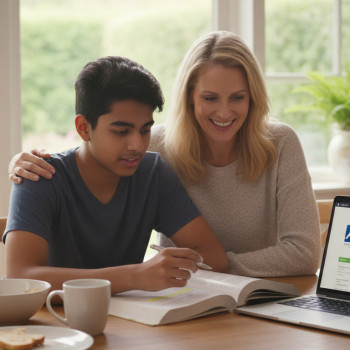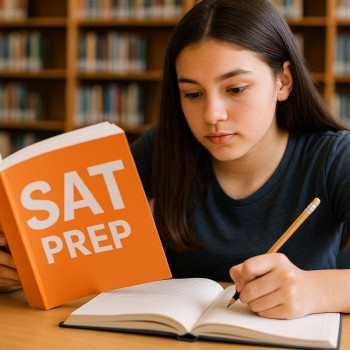Introduction: Why the SAT morning matters more than you think
There’s a strange kind of electricity buzzing through any house the morning of a big test. For many families, SAT morning is the crescendo of months of practice, nerves, and dreams about college. But while studying and practice tests build skill, the way that morning unfolds can have an outsized effect on how your child performs. A flustered departure, a forgotten charger, or an adrenaline spike can turn a well-prepared student into a shaky one.
This post is a calm, practical blueprint you can use as a parent (or student) to make that morning go smoothly. Consider this a gentle, step-by-step guide: part logistics, part psychology, and part parenting wisdom—with real-world examples, a few checklists, and a table you can screenshot and share. Wherever helpful, I’ll point out how one-on-one, personalized tutoring and tailored study plans (for example, Sparkl’s 1-on-1 guidance with expert tutors and AI-driven insights) can reduce morning stress by increasing confidence and preparedness beforehand.
Start the night before: the unsung hero of calm test mornings
How the night before goes is often more predictive of a calm morning than anything you do at dawn. Here are focused steps to take together the evening prior.
Practical prep checklist
- Lay out everything to bring: approved photo ID, device with Bluebook installed, fully charged charger, backup battery or power bank, ear buds (if allowed), pencils/change for locker, admission ticket or email confirmation (screenshot). Put them in one bag or box so nothing gets forgotten.
- Confirm device readiness: ensure the testing device meets requirements, Bluebook app is installed and updated, and any necessary software updates are completed overnight (not the morning of the test).
- Pack breakfast that’s familiar and easy to digest—think a banana, toast, yogurt, or a smoothie. Avoid heavy foods that might slow them down or make them sleepy.
- Set two alarms: one on the phone and one on a separate device (or the parent’s alarm). Place the phone or device across the room so your child must get up to turn it off.
- Agree on departure time and travel plan. If you’re driving, factor in traffic and parking. If taking public transport, check schedules and add a buffer for delays.
The emotional check-in before bed
Short, compassionate conversations the night before can reduce anxiety. Keep it brief and non-judgmental: ask how they’re feeling, acknowledge the nerves as normal, and remind them of concrete things they’ve accomplished in practice. Praise effort, not just potential score outcomes.

Morning-of blueprint: rhythm, not panic
On test day, small rituals and predictable routines calm the nervous system. The goal is to replace frantic energy with focused readiness.
Wake-up routine (first 60 minutes)
- Let them wake on their own if possible. If they need encouragement, use a calm, upbeat voice—avoid drills or last-minute quizzing.
- Hydration first: a glass of water right away to kickstart clarity.
- Light movement for 5–10 minutes: a short walk, gentle stretching, or even a few jumping jacks to get blood flowing and reduce cortisol. Movement is a powerful, evidence-backed way to reduce test anxiety.
- Fueling: serve the planned breakfast. Include protein and complex carbs for steady energy (e.g., peanut butter toast, scrambled eggs with a banana, or a Greek yogurt parfait with berries).
- Two-minute breathing exercise: inhale for 4, hold for 4, exhale for 6. Repeat 4 times. This reduces immediate anxiety and can be taught in minutes beforehand.
Final 30-minute checklist
- Quickly review only pre-agreed lightweight reminders (e.g., “Pace yourself,” “Use the process of elimination”), not dense content.
- Confirm everything is in the bag. Use the checklist from the night before.
- Leave early. Aim to arrive at the test center with at least 20–30 minutes to spare—this creates buffer time to breathe and adjust.
What to say (and what not to say) before the car leaves
Words matter. On the drive to the test center, many parents try to reassure—sometimes it helps, sometimes it backfires. Here are phrases that soothe and some to avoid.
Helpful phrases
- “You’re ready. You’ve put in the work. Breathe and do your thing.”
- “Treat this like practice with stakes. Be curious—what does the test ask you to do?”
- “I’ll be here when you finish, no matter what.”
Phrases to avoid
- “Don’t mess this up.”
- “What if you get a low score?”
- Rapid-fire quizzing or last-minute formulas—this creates cognitive overload.
Bring this: a simple, printable morning-of table
Save or screenshot this compact table and tape it inside the bag or on the fridge the night before. It’s a fast visual cue that helps reduce last-minute panic.
| Item | Why it matters | Done? |
|---|---|---|
| Photo ID | Required for admission | [ ] |
| Charged device with Bluebook | Primary testing platform | [ ] |
| Charger & backup battery | Protects against technical failures | [ ] |
| Admission ticket / confirmation | Needed if requested by staff | [ ] |
| Simple breakfast + water | Keeps energy and focus steady | [ ] |
| Comfort item (small) | Normalizes nerves—e.g., a lucky coin or note | [ ] |
Calming strategies for acute anxiety moments
No plan prevents nerves entirely. When anxiety spikes on the way to the center or in the waiting room, these micro-strategies help.
Breathing and grounding tools
- Box breathing: 4–4–4–4 as described earlier—quick and effective.
- 5-4-3-2-1 sensory grounding: name 5 things you see, 4 you can touch, 3 you hear, 2 you smell, 1 you taste (or a favorite thought). This brings attention out of the worry loop and into present reality.
- Anchor phrase: a short affirmation like, “One question at a time,” said quietly, can reframe focus.
Parent behavior checklist while waiting
- Stay present and quiet; avoid pacing or fretting visibly.
- If your child wants to talk: listen more than you instruct. Reflective listening calms anxiety.
- If they want silence, give it. Respect their needs rather than projecting your own nerves.

When technology hiccups happen: stay calm and have a backup plan
Digital testing reduces some friction, but introduces others. Device problems can be alarming. Prepare for them so you don’t escalate panic during the few minutes that matter.
Practical troubleshooting steps
- Bring the charger and a fully charged backup battery—this is often enough to avoid most failures.
- If Bluebook fails to launch: have your child raise their hand immediately and follow proctor instructions. Proctors are trained to handle tech issues.
- Encourage your student to breathe and not to spend energy catastrophizing; a calm response helps the proctor solve the problem faster.
After the test: decompress with intention
Once the test is over, the family response matters. Over-celebration or criticism can both be damaging. The aim is to restore equilibrium and gather useful lessons.
Post-test conversation template
- Ask two questions: “How did it feel?” and “What did you notice went well?”
- Avoid asking for a score estimate or criticizing timing. Focus on process notes: pacing, question types that felt easy or hard, and any tech hiccups.
- Celebrate the effort—go for a favorite meal, a walk, or a small treat. Acknowledge the emotional toll and the accomplishment of finishing.
Long-term strategies that make the morning easier
Short-term tactics are vital, but the best way to calm any test morning is to reduce uncertainty ahead of time. Over weeks and months, these strategies build automaticity and confidence.
Practice under realistic conditions
- Use full-length, timed practice modules on Bluebook or official practice tools so the digital interface feels familiar.
- Simulate the morning: practice waking up, eating the same breakfast, and completing a practice test at the same hour you’ll take the official SAT. This conditions the body and mind.
Build a predictable toolkit
- Teach and rehearse one breathing technique and one grounding exercise—make them automatic go-to tools.
- Create a physical bag of everything to bring and rehearse packing it weekly in the month before the test.
How personalized tutoring helps reduce morning stress
When students feel confident academically and have practiced strategies tailored to their learning style, they’re less likely to be overwhelmed when the test begins. Personalized tutoring—like Sparkl’s 1-on-1 guidance—can:
- Provide individualized study plans that target weak areas so mornings aren’t spent panicking over last-minute content.
- Offer expert tutors who coach pacing, test strategies, and stress-management techniques specific to the Digital SAT format.
- Use AI-driven insights to identify predictable question types or timing issues, so students know what to expect and practice under similar conditions.
Real-life example: The Harrisons’ test day
At suburban Cleveland High, the Harrisons had a ritual. Their daughter, Maya, had done months of digital practice on Bluebook and spent six weeks with a Sparkl tutor who created a pacing plan for her. The night before, they checked the device, packed the bag, and agreed on a 7:00 a.m. departure.
On the morning, Maya woke calmly. They ate toast and eggs, did a two-minute breathing routine, and left with time to spare. At the test center, when a short software update added 10 minutes to the waiting period, Maya quietly used her grounding routine instead of spiraling. Afterward, Maya said the best part was feeling like she had handled the situation—she’d practiced for it, and that practice changed everything.
Quick reference: Do’s and Don’ts for SAT morning
| Do | Don’t |
|---|---|
| Prepare the night before | Try to cram facts in the car |
| Bring chargers and backups | Assume devices will work without checking |
| Use short breathing exercises | Overwhelm them with last-minute drills |
| Keep conversations calm and supportive | Make high-stakes statements or threats |
When things go wrong: stories and scripts
Even with the best plans, things sometimes go off-script. Below are short example scripts you can use, tailored to common scenarios.
Scenario: Device won’t start at check-in
Parent script (quietly): “Okay, let’s raise your hand and tell the proctor. We’ll let them handle it. You won’t lose that focus—breathe with me for 30 seconds while we wait.”
Scenario: Student is overwhelmed in waiting room
Parent script: “I hear you—this is tough. Let’s do a quick exercise: breathe with me for four counts. When you’re ready, we’ll go in together and take it one question at a time.”
Putting it all together: a sample timeline for test morning
Here’s a practical timeline you can adapt. Adjust times to match your test slot.
- 5:45 a.m. — Gentle wake-up and hydration
- 6:00 a.m. — Light movement and breakfast
- 6:20 a.m. — Two-minute breathing and final bag check
- 6:30 a.m. — Leave with buffer time for traffic
- 7:00 a.m. — Arrive at test center, check-in, grounding exercise if needed
- 7:30–8:00 a.m. — Test starts (times vary by center)
Final thoughts: you are the anchor
Parents often underestimate how much their own calm matters. Teens look to you for emotional cues; when you are steady, they’re more likely to be steady too. The morning of the SAT is not just logistical—it’s relational. Your presence, measured words, and practical preparation create a container where your child can show what they know.
Remember: one test does not define a life. But a calm, well-organized morning helps students show their best work. With a few simple rituals, practical preparations, and ongoing targeted practice—especially when paired with personalized tutoring for pacing and confidence—your child can walk into the Digital SAT ready to do what they’ve practiced to do.
Resources to keep handy
- Printable morning-of checklist (use the table above)
- Two-minute breathing routine: 4–4–6 box breath
- Contact info for the test center saved on your phone
- Plan for post-test decompression: favorite snack, walk, or low-key celebration
A final encouraging note
Your teen is not alone in this. The more you plan ahead, practice real conditions, and model calm, the more the test morning will feel like just another day where they get to do their best. If you want extra help setting up a tailored study plan, targeted pacing strategies, or confidence-building sessions the weeks leading up to the SAT, consider exploring personalized 1-on-1 tutoring options that provide expert coaches and AI-driven insights to make mornings like test day feel familiar and manageable.
Deep breath. You’ve got this as a family—and your child has everything inside them to take on the day.














No Comments
Leave a comment Cancel